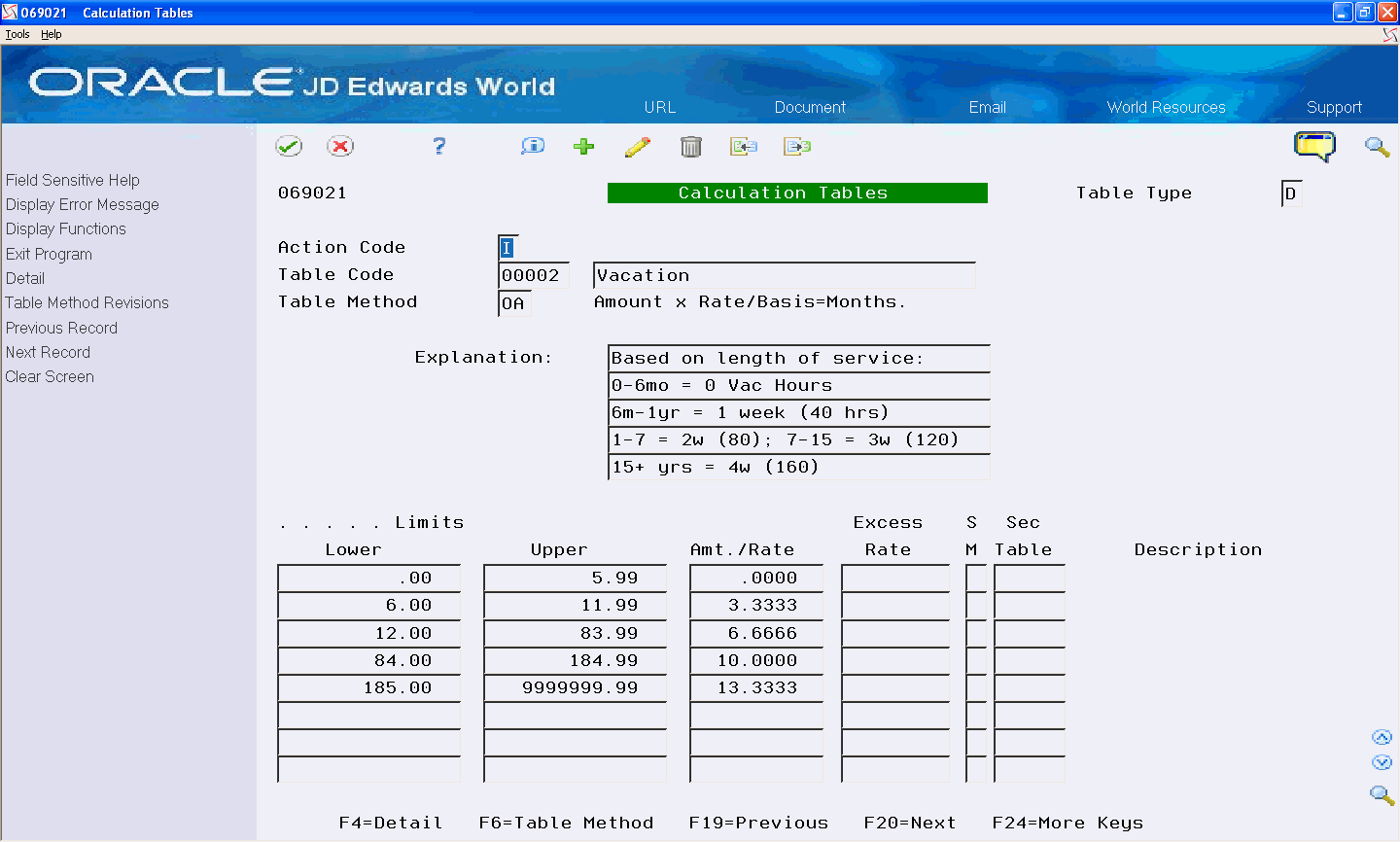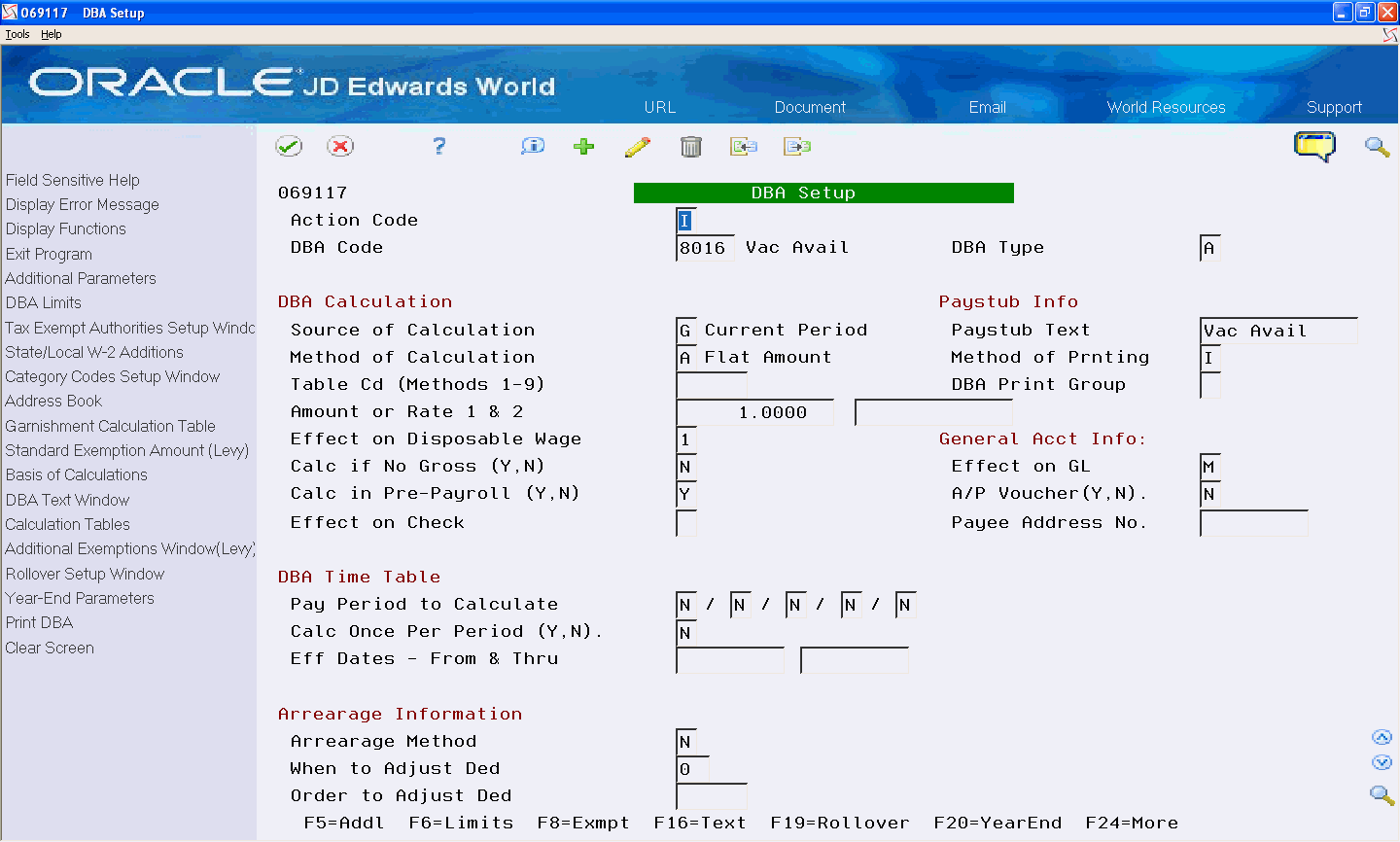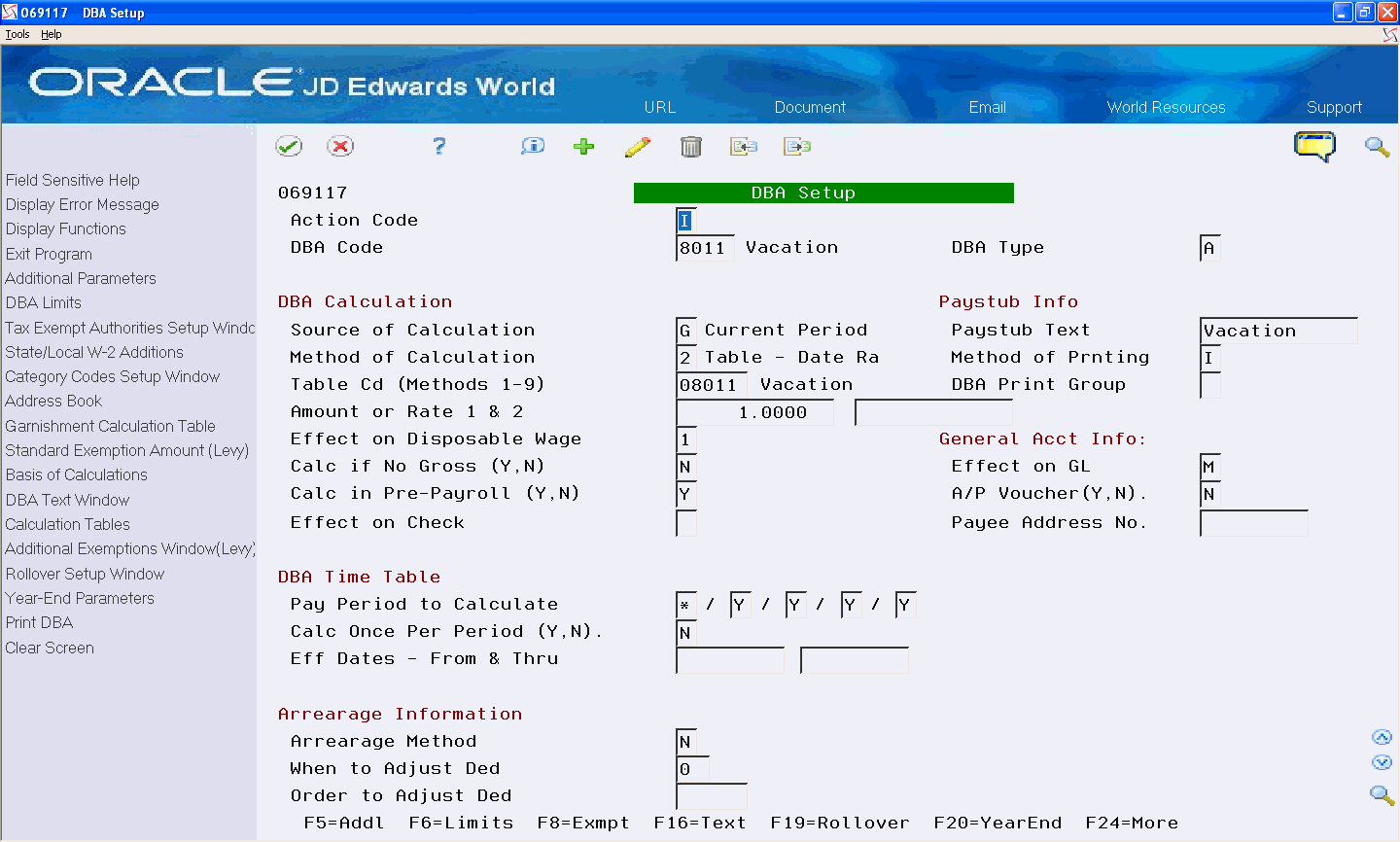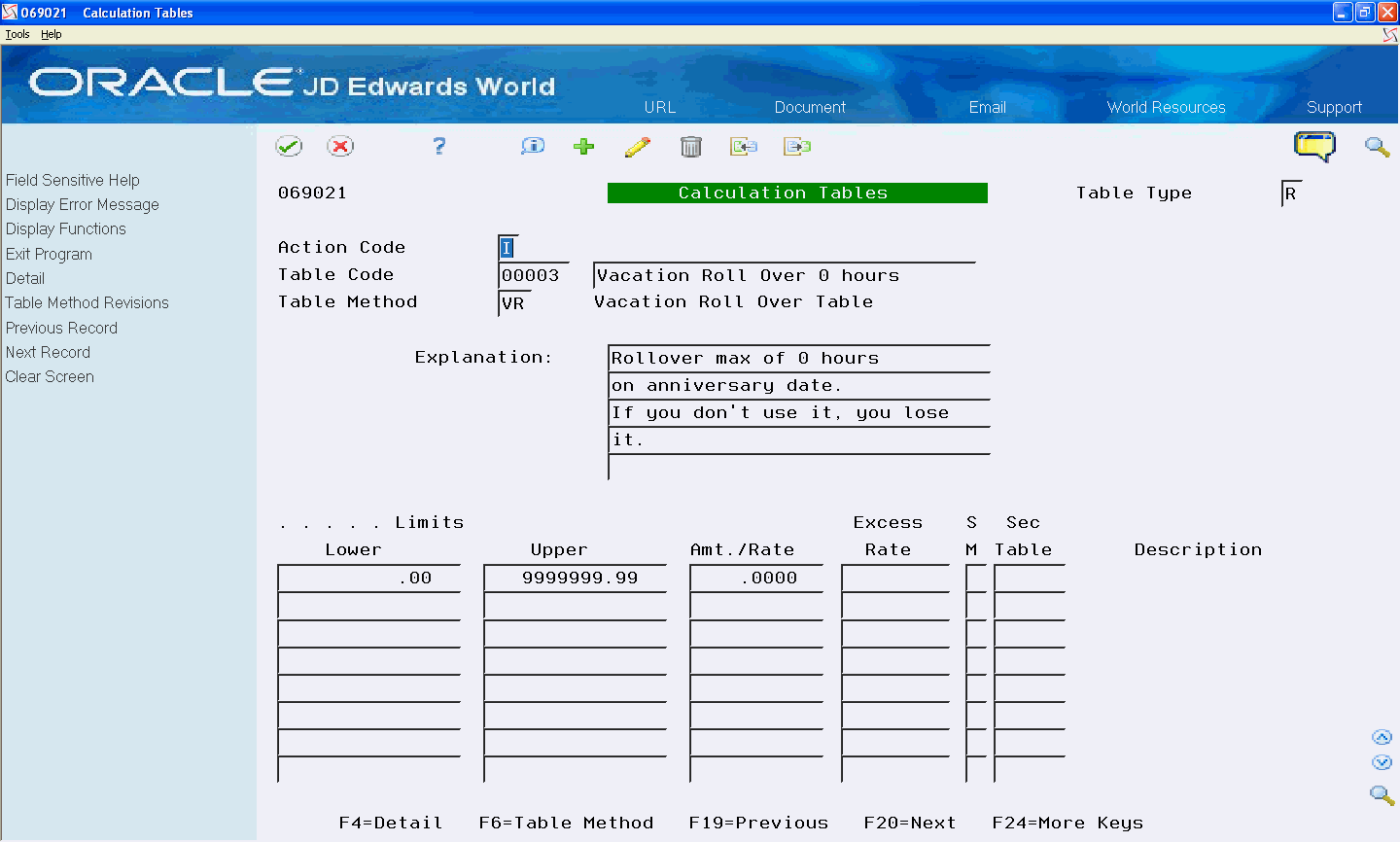3 Working with Rollovers
You use rollover programs to carry forward balances for pay types, deductions, benefits, and accruals (PDBAs) at the end of the year and to create the beginning balances for the next year. You need to carry forward these balances to correctly process payroll cycles in the new year.
For PDBAs with ending balances that do not need to be calculated, the system rolls over the accumulated total to the new year. No special DBA setup is necessary. However, you must set up rollover information for the DBA when you must calculate benefits and accruals with balances. (For example, you might need to subtract vacation taken from vacation available before the system can roll over the balance.) You must also set up rollover information for all DBAs that have balances that you must roll over at a time other than the end of the calendar year.
Note:
It is not necessary to install the software update prior to running the rollover programs.You can specify the following types of years for rollovers:
-
Standard year: the calendar year, January through December
-
Fiscal year: your organization's fiscal year
-
Anniversary year: employee anniversary dates, such as birth date or hire date, when the rollover date (year-end date) varies for each employee
-
User defined year: a user defined date
The Payroll system provides two types of rollover programs:
| Rollover Program | Description |
|---|---|
| Year-End | Use the Year-End Calendar Month Rollover and Year-End Payroll Month Rollover programs to process DBAs that roll over balances at the end of the standard year. These programs use the previous year's DBA balances to create beginning balances for the new year. You must run these programs after you process the last payroll of the year.
The system maintains historical balances for the standard year in the following tables:
|
| Fiscal and Anniversary | Use the Fiscal or Anniversary Rollover program to process DBAs that are set up to roll over balances at times other than the end of the standard year.
The system maintains historical balances for fiscal and anniversary years in the Fiscal/Anniversary Year History table (F06147). |
The system maintains balances in different tables because of the differences among calendar months, payroll months, calendar years, fiscal years, and anniversary years. For example, when a pay cycle crosses calendar months, monthly DBA totals are different for the payroll month and calendar month, but year-to-date (YTD) totals remain the same (unless the cycle also crosses calendar years).
Only the year-end rollover programs are relevant to year-end processing.
Working with rollovers includes the following tasks:
3.1 Entering Rollover Information for DBAs
Employees can earn or hold balances for some DBAs that the system must carry over, or roll over, from one year to the next. When you set up the DBA, you must enter rollover information so that the system can calculate the balance to roll over.
The system rolls over DBAs that have any of the following:
-
Remaining balances
-
Remaining periods
-
An inception-to-date limit
-
An annual carryover limit
-
Deduction amounts due
-
Arrearages
You also enter rollover information so that the system can store history for the DBA.
For most types of DBAs, such as Registered Retirement Savings Plan (RRSP) benefits and medical deductions, the system carries forward year-end balances when you run the standard year-end rollover programs.
You can set up vacation and sick DBAs in either of the following ways:
-
When an employee accrues time that becomes available later, you set up two DBAs. The first DBA accrues the time. The second DBA tracks the amount of time that is available to the employee.
-
When an employee may take time as they earn it, you set up a single DBA to track accrued time.
Either of these scenarios might also involve a limit to the number of hours that an employee can carry forward to the following year.
Note:
You cannot relate a pay type to multiple DBAs that you base on different rollover years. For example, your organization might use the following vacation accruals:One accrual for office workers that rolls over balances at the end of the standard year.
One accrual for factory workers that rolls over balances on employees' hire dates To record employees' vacation time taken, you must use separate pay types for each of these accruals.
3.1.1 Example: Limit on Vacation or Sick-Leave Rollover
Your organization's vacation or sick-leave policy might state that employees cannot carry forward more than 80 hours from one year to the next.
To administer this policy, you set up a calculation table that allows only 80 hours to roll over to the following year. The table is associated with the DBA that tracks availability.
The available amount might include a beginning balance from a prior year.

Description of the illustration ''calc_tables.gif''
The system compares the balance with the limit on the table. The system does not roll over any amount to the new year that is over the limit.
Alternatively, your organization's vacation or sick-leave policy might state that employees cannot carry forward hours from one year to the next. To administer this policy, you define 0 (zero) as the limit in the rollover calculation table.
3.1.2 Example: Vacation Rollover for Time Not Immediately Available
Your organization's vacation policy might state the following:
-
Employees accrue vacation time at the rate of four to ten hours per month, based on years of employment.
-
Employees may take vacation time in the calendar year following the year in which they earn the vacation time.
To administer this vacation policy, you set up the following:
-
A pay type (such as 815, Vacation Pay) that tracks the vacation time that an employee uses.
-
An accrual (such as 8015, Vacation) that tracks the vacation time that an employee earns. The accrued time rolls over to a second DBA that tracks the available vacation time. Accrued time is not available until it rolls over.

Description of the illustration ''dba_setup.gif''
-
An accrual (such as 8016, Vacation Available) that tracks the vacation time that is available to the employee. The accrual rollover table that is associated with the second DBA establishes the limit on the amount of vacation time that can roll over to the following year.

Description of the illustration ''dba_setup_1.gif''
When you set up accrual 8016, Vacation Available, you enter the following rollover information:
-
In the Benefit/Accrual Type field, enter V (Vacation Pay).
-
In the Rollover Table field, enter the table code of the table that you just created so that the mandated amount rolls over.
-
In the first Related PDBAs field, enter the number of the pay type that you use for vacation pay.
-
In the next Related PDBAs field, enter the DBA number of the accrual that represents accrued but not yet available hours.

Description of the illustration ''rolver_stup_wndow.gif''
When you run the rollover program, the system calculates the balance to roll over by adding the accumulated and available balances and then subtracting the vacation time that the employee has taken.
You would not enter any information on the Rollover Setup Window for accrual 8015.
Note:
You can create as many pay types and accruals as you need. For example, you can have many accrual DBAs that roll over to a single available DBA. You can also have many pay types that roll over to a single available DBA.3.1.3 Example: Vacation Rollover for Time Immediately Available
Your organization's vacation policy might state the following:
-
Employees may take vacation time as they earn the time.
-
Employees accrue vacation time at the rate of four to ten hours per month, based on years of employment.
-
Employees cannot accumulate more than 80 vacation hours from the start to the end of the DBA (the calendar or fiscal year) unless they take the time during the term of the DBA.
To administer this vacation policy, you would set up the following:
-
A pay type (such as 811, Vacation Pay) that tracks the vacation time that an employee takes
-
An accrual (such as 8011, Vacation) that tracks the vacation time that an employee earns

Description of the illustration ''dba_setup_2.gif''
When you set up accrual 8011, you would do the following:

Description of the illustration ''rolver_stup_wndow_1.gif''
-
In the Benefit/Accrual Type field, enter V (Vacation Pay).
-
In the Rollover Table field, enter the table code of the table that you just created so that the mandated amount rolls over.
-
In the Related PDBAs field, enter the number of the pay type that you use for vacation pay (811).
When you run the rollover program, the system calculates the balance to roll over by subtracting the vacation time taken from the vacation time earned.
3.1.4 Before You Begin
Set up the pay types that you will use to calculate the balance for the DBA that requires rollover information.
To enter rollover information for a DBA
From Pay/Deductions/Benefits (G7742), choose DBA Setup
-
On Rollover Setup Window, choose Rollover Table (F17) to define carryover limits.
-
Enter VR in the Table Method field.
-
Enter the number of months of service from the original hire date in the following fields:
-
Lower Limit
-
Upper Limit
-
-
Complete the following fields:
-
Table Code
-
Amount/Rate
-
-
Click Add.
-
Choose Rollover Setup Window (F19).
-
On Rollover Setup Window, complete the following fields and click Enter:
-
Benefit/Accrual Type
-
Rollover Table
-
PDB
-
| Field | Explanation |
|---|---|
| Table Type | A code that defines the purpose of the table. Valid values are:
D – The system uses the table to calculate DBAs. R – The system uses the table to determine limits for rolling over sick and vacation accruals. |
| Table Method | A user defined code (00/UM) that designates any unit of measure that is appropriate for an employee's time and pay. |
| Table Code | A numeric code that identifies this table in the Generic Table Constants table (F069026). |
| Amt./Rate | The amount or rate that the system uses to calculate a DBA. When you enter 1, 2, 3, 4, 5, or 6 as the method of calculation, you must enter a value in this field to use in the calculation in conjunction with the basis table.
For example, if you create a calculation table for vacation rollovers and enter 80 in this field, any amount that exceeds 80 does not roll over to the following year. Therefore, an employee who has 92 hours of available vacation at the end of the year loses 12 hours of vacation time and begins the new year with 80 hours of vacation time. |
| Bnft/Accrl Type | A user defined code, 07/SV, that specifies whether the benefit or accrual type is sick, vacation, holiday, leave, or other. The system uses this code to print sick and vacation accrual balances on the payment stub. |
| Rollover Table | The identification number of the rollover table that the system uses to limit the amount rolled over for an accrual.
For example, you can base the limit on an employee's months of service. You can set up the table so that an employee with 0 through 12 months of service can roll over up to 40 hours at year-end and an employee with 13 through 999 months of service can roll over up to 80 hours. |
| PDBA | The number and description of the PDBA that you want the system to use to calculate the corresponding PDBA. This number is the beginning number in the range that is the basis of the calculation.
Screen-specific information For rollover setup, this is the number and description of the PDBA that the system uses to calculate a remaining balance, for example, a pay type that deducts from the current balance. The remaining balance becomes the beginning balance for the new year. |
| Table Type | A code that defines the purpose of the table. Valid values are:
D – The system uses the table to calculate DBAs. R – The system uses the table to determine limits for rolling over sick and vacation accruals. |
3.2 Processing Rollovers
From Integrity and Rollover (G772471), choose Year End Rollover
You use rollover programs to carry forward balances for pay types, deductions, benefits, and accruals (PDBAs) at the end of the year and to create the beginning balances for the next year. You need to carry forward these balances to correctly process payroll cycles in the new year.
You use the year-end rollover programs to process DBAs that roll over balances at the end of the standard year. You must run these programs after you process the last payroll cycle of the year. These programs use the previous year's DBA balances to create beginning balances for the new year.
In some cases, you might want to roll over DBA balances at times other than the end of the calendar year. For example, you might want to roll over vacation accrual balances on employees' hire dates. You use the Fiscal or Anniversary Rollover version to process DBAs that are set up to roll over balances at times other than the end of the standard year.
Note:
When a payroll cycle crosses into the next year, the system stores the history in the pay-period ending date field and prorates the amount to both years during pre-payroll processing. The system creates the following two records in the DBA Transaction Detail table (F0609):-
Rollover amount for the current year.
-
Rollover amount for the next year.
You use two versions of the year-end rollover program to process DBAs that roll over balances at the end of the standard year. You must run these versions after you process the last payroll cycle of the year. These versions use the previous year's DBA balances to create beginning balances for the new year.
You need to run two rollover versions before you run the first payroll of the new year. These versions are:
-
Year-End Payroll Month Rollover - Run this version after the last cheque date of the current year and before the first cheque date of the new year.
-
Year-End Calendar Month Rollover - Run this version after the last payroll with work dates in the current year.
The following table illustrates an example of when you must run each rollover version.
| Pay Period Ending Date | Cheque Date | Run Payroll Month Rollover | Run Calendar Month Rollover |
|---|---|---|---|
| 12/31/19 | 12/31/19 | After this payroll | After this payroll |
| 12/31/19 | 01/05/20 | Before this payroll | After this payroll |
| 01/05/20 - with work dates in 2019 and 2020 | 01/05/20 | Before this payroll | After this payroll |
The Payroll system maintains standard-year balances for all PDBAs in the following tables:
-
The Year-End Calendar Month Rollover program uses the Calendar Month DBA Summary History table (F06145).
-
The Year-End Payroll Month Rollover program uses the Payroll Month PDBA Summary History table (F06146).
The system updates the Calendar Month DBA Summary History table by work date and the Payroll Month PDBA Summary History table by cheque date.
You use the same DREAM Writer program to process both types of rollovers. Although you can run both versions at the same time, JD Edwards World recommends running two different versions at different times.
First, you set the processing options of the rollover programs to run in proof mode. When you run the rollover programs in proof mode, the system identifies possible errors without changing any information in the history table. Review the reports for errors. When beginning balance hours or monetary amounts are negative, the rollover creates the Year-End Rollover report and includes a message that the rollover amount is negative.
After you correct any errors, rerun the rollover programs in update mode.
Note:
If an employee worked in more than one company last year, the payroll history rollover combines like PDBAs from the individual companies and carries over the total to the employee's current home company. The report also prints a separate line showing the detail for each company. If you do not want to combine the employee's accruals, create a unique payroll-month history version for each company. If an employee has sick or vacation pay history in multiple companies, the system combines all hours for each pay type before subtracting the total hours from the combined history for the related accrual.If different groups of employees have unique rollover rules for the same DBA, you must create a separate payroll-month history version for each group. Set up each version so that it selects only those employees in that group.
3.2.1 Before You Begin
-
Set up the rollover information for DBAs. See Entering Rollover Information for DBAs
-
Create a copy of the Payroll Month History (F06146) and Calendar Month History (F06145) tables. The system does not automatically create backup copies when you run the year-end rollover programs.
